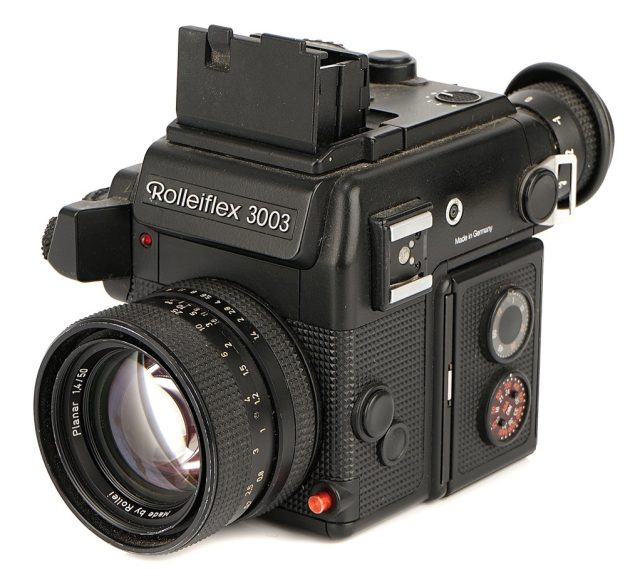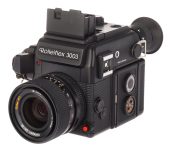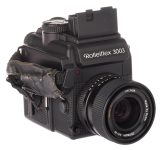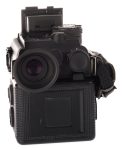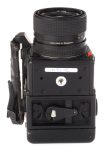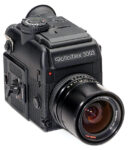Announced
Production status
System
Rolleiflex 3003
35mm MF film SLR camera • Discontinued
Specification
| Format: | |
| 35mm full frame | |
Film type: | 135 cartridge-loaded film |
| Rollei QBM [44.46mm] | |
| Shutter: | |
Type: | Focal-plane |
Model: | Electronically controlled |
Speeds: | 16 - 1/2000 + B |
| Exposure: | |
Exposure metering: | Through-the-lens (TTL), open-aperture |
Exposure modes: | Aperture-priority Auto |
| Manual | |
| Physical characteristics: | |
Weight: | 1350g |
Dimensions: | 159x111x89mm |
Manufacturer description
Camera type: Single-lens reflex camera with interchangeable film magazine, two integral viewfinder systems and built-in motor drive. Highly integrated analogue/digital control circuits, central control and monitoring of all measurement and drive functions.
Picture format: 24 x 36 mm.
Film type: Type 135 35 mm film cartridges for 12, 20, 24, 36 or 72 exposures, and also sheet film and bulk film stock.
Film speed: Magazine setting: 15-39 DIN (25-6400 ASA).
Exposure metering: Through-the-Iens Rollei selective metering, using open or working aperture. Measuring field shown on the viewfinder image. Exhosure correction: -1 to +2 EV intervals. Sensor: two silicon photodiodes.
Measurement range: Exposure values 1-18 for 21 DIN/100 ASA film with aperture 1:1.4.
Shutter: Vertical-running metal-blind focal-plane shutter. Electronically controlled. Automatic selection of shutter speed with aperture priority, or manual exposure balance (follow-up system). Shutter speeds : 1/2000 sec to 16 sec, automatic or manual setting, time exposure B, flash synchronization speed 1/100 sec to 16 sec, X = 1/100 sec.
Interchangeable lenses: Rollei QBM bayonet interlocking with iris simulator, Zeiss lenses with focal length from 15 to 1000 mm, Rolleinar lenses with focal length from 14 to 500 mm and zoom lenses.
Shutter release: Three microswitches, one on each side of the camera as well as one on the top right for reportage applications using the loop handgrip. Electronically controlled automatic release.
Film transport: Built-in high-performance motor. Single or continuous release at around 3 pictures per second.
Multiple exposure: By means of a switch on the magazine.
Reflex mirror: Damped swinging mirror, hard coated.
Viewfinder systems: Two built-in viewfinders: (1) Telescopic viewfinder with rotatable eyepiece for dioptre adjustment and rubber eyecup. (2) Hood with interchangeable viewfinder attachments. Standard version: folding viewfinder hood with flip-up magnifier. Seven interchangeable focusing screens. Can be changed without tools.
Viewfinder information: Indication of aperture by luminous numbers (LEDs). Indication of shutter speed by luminous numbers (LEDs). Indication when shutter speed range is exceeded. Identification of measuring field for exposure metering. Indication of "flash ready" and under-exposure when automatic flash is used. Memory function. Indicator for exposure correction.
Flash synchronization: 1/100 sec. Accessory shoe with synchronizing centre contact and contacts for automatic flash units with Rollei SCA 356 or Metz C 70 special adapters.
Automatic flash control: TTL flash metering in the film plane by means of additional photodiode with "flash ready" indication and exposure monitoring in the viewfinder.
Power supply: Quick-change power pack with soldered-in NiCd batteries. Can be replaced by external electrical supply connection . Charger for normal charging rate. Charging time 14 hours.
Interchangeable magazines: With drawslide for quick change of partly exposed films. For 12-, 20-, 24-, 36- or 72-exposure films, and also for sheet film. Exposed film can also be removed with the magazine attached. The magazine interlocks to prevent errors in operation. Facility for single and multiple exposures. The film speed can be set between 15 and 39 DIN (25 and 6400 ASA). The frame counter only operates when the magazine is loaded. Memo holder for tear-off tab from film box. Polaroid magazine for Polaroid film pack (two pictures 24 x 36). Long-film magazine for 250 exposures.
Connections: Multiple socket for electrical remote release cable, timer, infrared remote operation. 1/4" tripod bush.
***
Function defines form
The unusual design of the Rolleiflex 3003 is unique among cameras in the 24 x 36 mm format. The impressive shape of this model is primarily determined by function. Its design is based on the concept of combining the proven elements of medium-format technology with the comfort and speed of the ideal modern 35 mm camera, thus creating a new and superior class of pioneering professional 35 mm SLR camera.
The systematic development of this concept has produced the distinctive look of the Rolleiflex 3003. The camera's handy, compact cube shape is the result of completely new product features and intensive ergonomic studies. For this reason, the Rolleiflex 3003 offers an ease of handling that is unique in this class of camera.
Light and easy to handle - universally adiustable
The Rolleiflex 3003: a new dimension in cameras. Made in Braunschweig with Rollei's supreme precision. A marvellous synthesis of robust mechanics and the latest electronics.
For the photographer working in 35 mm, the camera technology of the Rolleiflex 3003 opens up opportunities that up to now were only available with professional medium-format models. The combination of the proven interchangeable film magazine system, the integral twin viewfinder system and the built-in high-performance motor is unique among 35 mm SLR cameras.
Despite its sophisticated technology, the Rolleiflex 3003 is an amazingly simple camera to operate. All the controls are arranged and shaped in such a way that they are easy to adjust in any position and in any situation. They can even be operated with gloves on. Modern electronics ensures that every creative idea can be realized with superlative precision. A well-designed monitoring and safety system practically eliminates sources of error and operating faults.
Completely trouble-free exposure control: you yourself couldn't make a more positive choice between light and dark
With the Rolleiflex 3003, you can be sure of the right exposure in any situation. The superlative technical features of this model are matched by its exceptional ease of operation. The exposure is automatically controlled (automatic shutter with aperture priority). The automatic system can be corrected by -1 to +2 EV intervals or can be switched over to manual exposure compensation (follow-up system).
Rollei selective metering
Most cameras integrate the measured brightness and build up an average value from the light and dark areas of the subject as a whole. With its special selective metering, the Rolleiflex 3003 precisely takes into account important subject details.
In most cases, simple integral measurement is good enough since about 80% of all photographs only show moderate contrast. But a top-class camera must also be able to cope with the other 20% of the cases directly without the need for intricate manipulations. Thus, in the Rolleiflex 3003, the measurement field is defined as a rectangular area in the viewfinder - a method superior in practice to the less accurate total area measurement and the slower spot measurement.
Measured value storage
If the important subject detail is not in the middle of the frame, the measured value can be held. The required framing can then be selected and the picture taken. It is particularly important to remember that the measured value memory functions with sequences of exposures as well as with individual pictures.
Multiple exposure
Particularly striking effects can be achieved by making two or more exposures one after another on the same negative or slide.
Working/open aperture metering
Working aperture metering is useful not only for monitoring the depth of field at a particular aperture, but also when using:
- older Rollei lenses without aperture transfer,
- non-standard lenses without aperture transfer,
- extension tubes not equipped for automatic operation,
- adapters of all types and bellows units.
The Rolleiflex 3003 proves itselfs to be completely trouble-free because the automatic features continue to function with working aperture operation.
With the Rolleiflex 3003, successful multiple exposures are no trouble at all.
Flashes of perfection - with automatic flash
The TTL flash metering system in the Rolleiflex 3003 reflects the state of the art. Automatic flash units and special adapters make it possible to master flash photography speedily and without problems - with no aperture restrictions either. The Rollei SCA 356 adapter (SCA 300 system) is suitable for flash units from Agfa, Braun, Metz, Osram, Philips and Regula. A sensor built into the camera body measures the light reaching the film through the lens. The special flash control electronics in the external special adapter then meters out the flash power required for the particular subject. The camera automatically sets the flash synchronous speed of 1/100 sec; "flash ready" and the correctness or incorrectness of the exposure are indicated in the viewfinder. Extension factors (e. g. when using bellows, extension tubes, converters, filters, etc.) are automatically allowed for in the metering. Of course other flash units can also be connected directly to the Rolleiflex 3003, without accessories, either by using the hot shoe with a centre contact or via a synchronizing cable.
With the specially designed pistol grip and flash extension unit 1, the flash can be mounted in any position next to the camera - right or left, above or below. In every position, the camera can be held easily and firmly.
The TTL flash metering system can be used with advantage in the close-up and macro range, as well as with the Rollei MF1 Macroflash. And even when using professional studio flash equipment, it is now possible for the first time, using the Rollei FM1 TTL flash exposure meter, to measure studio flash light through the lens. The meter will tell you the correct change of aperture or reduction in flash power to achieve perfect exposure as measured from the film plane. The meter will then check the final exposure measuring 0 or plus or minus EV factors. All this is achieved without wasting film or having to approach the subject with a conventional flash meter.
Unique feature: the built-in twin reflex viewfinder system, the individual perspective
Whether you're taking pictures flat on the ground, over your head or round a corner, you can now achieve the optimum view of your subject in any situation.
The telescopic viewfinder system is for normal applications: it is suitable for all types of photograph that you may want to take from the viewpoint of the human eye. A special feature is the facility to change the dioptre rating of the eyepiece to accommodate visual defects. This does away with the need to change the lenses in the eyepiece.
The hood viewfinder system is particularly suitable for unusual viewpoints - subjects near ground level, for example - but also for situations in which the subject cannot be viewed directly. Thus, it is possible to take photographs over crowds or walls, or from viewpoints that previously would have been out of the question. In these situations, you hold the camera over your head and look into the viewfinder from below.
You can change from the telescopic to the hood viewfinder in a flash. With the Rolleiflex 3003, you don't lose any time removing and fixing finder systems because they are already built into the camera. Focusing screens for the viewfinder can be changed easily without tools. You have a choice of seven different screens that can be interchanged to suit the subject. Hence, the Rolleiflex 3003 is a custom-built instrument for use in any photographic situation.
Clear information in the viewfinder
Shutter speeds are indicated on the left-hand edge of the viewfinder as soon as the shutter release is pressed to the first stop. If two speed indications light up at the same time, the camera uses the intermediate value.
The selected aperture is indicated on the right-hand edge of the viewfinder. When Rollei lenses not designed for the Rolleiflex SL 2000 or 3003 are used, the aperture cannot be indicated for technical reasons. In this case, all the aperture values in the viewfinder light up. However, this has no effect on the correct exposure measurement and the automatic operation of the camera.
The measurement field for selective exposure metering is recognizable in the viewfinder as a precisely defined light-grey rectangle.
Focusing aids. The standard focusing screen has a split-image rangefinder and micro-prism grid as a focusing aid. It can be interchanged with other focusing screens according to the photographic requirements.
Follow-up exposure adjustment. When the exposure is set manually, a shutter speed indicator will flash if the setting is not correctly balanced. As soon as the correct shutter speed is obtained by alteration of aperture and/or speed, the light in the viewfinder will glow steadily.
The "memo" function: measured value storage is signalled by the fact that only the shutter speed indicator lights up.
Flash monitoring. When automatic flash is used, a green flash symbol in the viewfinder indicates when the flash is ready. After the flash exposure, the flash symbol indicates whether the light output of the flash was sufficient.
Exposure correction. When you are working with exposure correction, a red LED reminds you to switch off again before taking photographs in the normal way.
Unique feature: the built-in high-performance motor
This is also a first for a camera in this class. A high-performance motor efficiently and precisely operates all the camera functions, including the shutter and film transport.
Two modes of operation of the motor allow for individual exposures or sequences of exposures. When the release is pressed for a single picture, the motor moves the film on by just one frame. If rapid movements are to be captured or a series of frames is to be shot for information purposes, the continuous release provides photographs at 3 frames per second. Those who take a lot of photographs will appreciate this facility, for how often in action photography has the subject moved at the moment of shutter release so that you only hit the mark with a quick second shot.
Between shots the exposure is automatically checked and, if necessary, the shutter speed is corrected.
Designed as an uncomporomising motorized camera for the professional, the Rolleiflex 3003, with its interchangeable magazine, is altogether one of the fastest and most versatile camera systems available today.
Unique feature: the interchangeable magazine system
The Rolleiflex 3003 is the only 35 mm reflex camera in the world with a professional interchangeable magazine system. This enables you to take advantage of the sweeping developments in photochemistry, which have given a new impetus to professional photography with new films and emulsions: high-speed colour film for photography with very short exposure times or true-to-life atmospheric pictures in poor light conditions; colour transparency film for bright projection or rapid direct copying; black-and-white film that is both highly sensitive and very fine-grained. With the Rolleiflex 3003 and its unique interchangeable magazine system, you will always be able to cope with future innovations in chemistry.
Quick magazine change means exacting creative photography. You can change quickly and easily from colour to black-and-white film, from standard to high-speed film, from negative to reversal film - without losing any pictures from partly-exposed films.
In this way, the use of several magazines can multiply the creative possibilities of the Rolleiflex 3003. The performance of the camera will no longer be hampered by a film that does not meet the changed photographic situation.
Inside a church you are taking atmospheric pictures with a super high-speed film. For further photographs outside, the range of shutter speed/aperture combinations is not sufficient or else the grain is disturbingly noticeable. A second magazine with standard film provides the ideal solution to the problem.
An ingenious interlock system prevents errors in operation. The cassette can only be disengaged when the magazine drawslide is inserted, protecting the film from unwanted light. On the other hand, the camera shutter can only be released when the drawslide is pulled out, leaving the film free.
From the editor
Manufactured 07/1984 - 06/1994 in Germany, 2,800 units only.
The weight and dimensions are indicated for the camera body with the Carl Zeiss Planar HFT 50mm F/1.4 lens mounted.
Special editions (2)
- Rolleiflex 3003 Traveller Set (500 units) - 1990
- Rolleiflex 3003 "Edition deLuxe" - 1987
